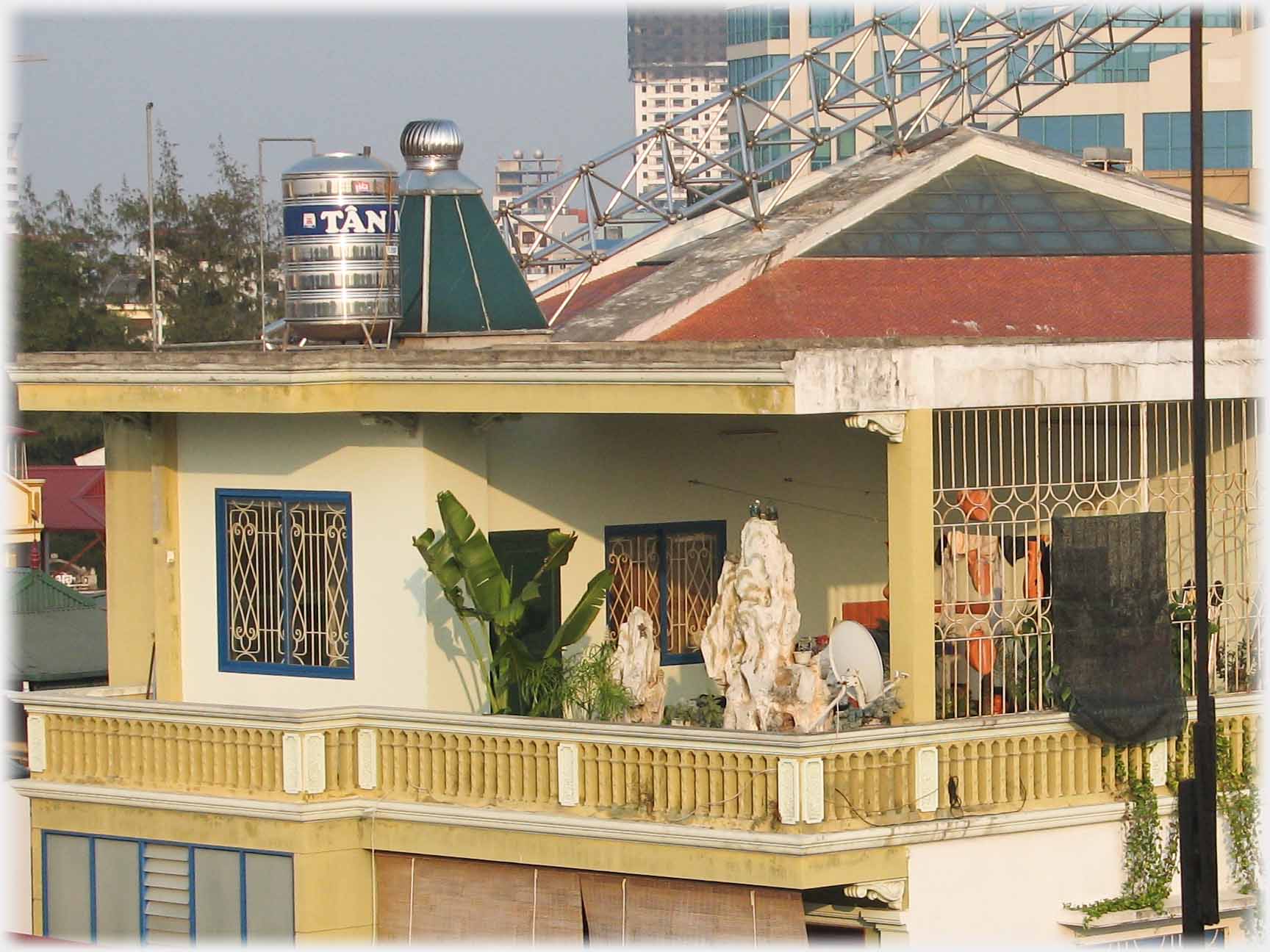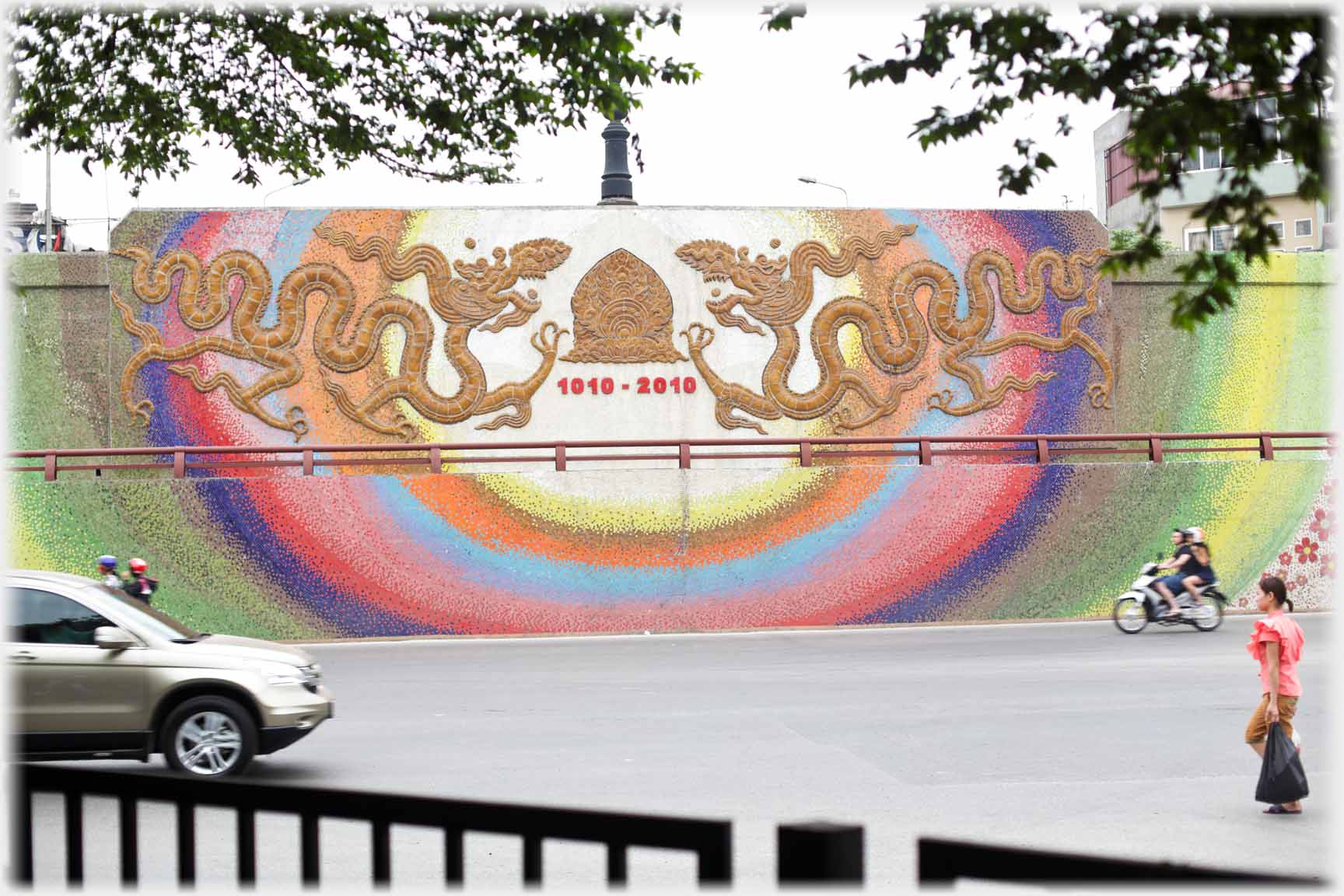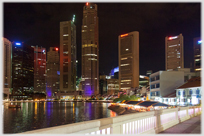 This is not a rouge gateway to the city of Hà Nội, rather a monument to an international company - Ciputra - and its attempt to make a two billion dollar development in the north west of the city in partnership with the Hà Nội government. That was 20 yeas ago, and there have been various developments in the area, although not along the lines envisaged then. The Indonesian company was named after its founder Ciputra who is now dead
This page takes you away from the turmoil of the central streets of Hà Nội to the more sedate suburbs. But the confusion of traffic is replaced by another activity, that of construction, from houses to tower blocks Hà Nội has been racing to home the millions who wish to migrate towards the city. Among the photos below two types of house dominate, there is the familiar narrow vertical form found everywhere in Vietnam, the shape being a function the price which is based on the width of the street frontage; and the huge tower blocks, such as those that have come to dominate the western edge of the city. These, along with similar massive developments to the south of Hà Nội, seem to be a common feature of far eastern cities.
This is not a rouge gateway to the city of Hà Nội, rather a monument to an international company - Ciputra - and its attempt to make a two billion dollar development in the north west of the city in partnership with the Hà Nội government. That was 20 yeas ago, and there have been various developments in the area, although not along the lines envisaged then. The Indonesian company was named after its founder Ciputra who is now dead
This page takes you away from the turmoil of the central streets of Hà Nội to the more sedate suburbs. But the confusion of traffic is replaced by another activity, that of construction, from houses to tower blocks Hà Nội has been racing to home the millions who wish to migrate towards the city. Among the photos below two types of house dominate, there is the familiar narrow vertical form found everywhere in Vietnam, the shape being a function the price which is based on the width of the street frontage; and the huge tower blocks, such as those that have come to dominate the western edge of the city. These, along with similar massive developments to the south of Hà Nội, seem to be a common feature of far eastern cities.
 The piers of the new bridge from the airport to the city centre, reflected in our car's bonnet
The piers of the new bridge from the airport to the city centre, reflected in our car's bonnet
 This is the old bridge to the airport, a double decker affair with the road running above the railway, and pedestrian access offered by labouring up those staircase towers in the tropical heat of a Hà Nội summer!
This is the old bridge to the airport, a double decker affair with the road running above the railway, and pedestrian access offered by labouring up those staircase towers in the tropical heat of a Hà Nội summer!
 Northern suburbs of the city looking towards the river, with typical high narrow houses
Northern suburbs of the city looking towards the river, with typical high narrow houses
 The roofs of the older single story buildings, with a familiar style of newer house rising above them
The roofs of the older single story buildings, with a familiar style of newer house rising above them
 A row of relatively grand middle class housing, the small turret, on the nearest house, proclaims money for decoration, and a detached villa, all with space for vegetable gardens
A row of relatively grand middle class housing, the small turret, on the nearest house, proclaims money for decoration, and a detached villa, all with space for vegetable gardens
 Distinguished only by rather mundane graffiti the wall in the above photo runs beside the main road from north of the city centre to the bridge two photos above. This wall is part of the flood defences of the city, and in preparation for the 1,000 year celebrations was revitalised...
Distinguished only by rather mundane graffiti the wall in the above photo runs beside the main road from north of the city centre to the bridge two photos above. This wall is part of the flood defences of the city, and in preparation for the 1,000 year celebrations was revitalised...
 ...The wall is some 6.5 kilometres (4 miles) long and was decorated following the idea of a woman journalist, Nguyễn Thu Thuỷ. Many organisations contributed to this spectacular work, including local schools and foreign embassies. A main junction is shown at the foot of this page
...The wall is some 6.5 kilometres (4 miles) long and was decorated following the idea of a woman journalist, Nguyễn Thu Thuỷ. Many organisations contributed to this spectacular work, including local schools and foreign embassies. A main junction is shown at the foot of this page
 Two of Hà Nội's most memorable features: narrow vertical houses and lakes.
Two of Hà Nội's most memorable features: narrow vertical houses and lakes.
Houses jostle to have a water frontage
 In the outer suburbs, the crowding diminishes, and a sense of the heat is seen in the dust. But water is constant feature of a city 120 kms from the sea and 10 metres above it
In the outer suburbs, the crowding diminishes, and a sense of the heat is seen in the dust. But water is constant feature of a city 120 kms from the sea and 10 metres above it
 At the outer edges of the town there is the occasional reminder of Vietnam's turbulent past here beside an irrigation channel: two pill boxes
At the outer edges of the town there is the occasional reminder of Vietnam's turbulent past here beside an irrigation channel: two pill boxes
 Apart from the lakes, and the huge Red River, this is the next most noticeable water feature, the canalised River Tô Lịch which curves through the centre of the city, and too often in the past, has been simply an open sewer
Apart from the lakes, and the huge Red River, this is the next most noticeable water feature, the canalised River Tô Lịch which curves through the centre of the city, and too often in the past, has been simply an open sewer
 Left, wooden scaffolding with a type of construction (reinforced concrete pillars with brick infills) which was first used in the U.S. early last century, Dumfries had the first British version in 1913.
Left, wooden scaffolding with a type of construction (reinforced concrete pillars with brick infills) which was first used in the U.S. early last century, Dumfries had the first British version in 1913.
 Right, concrete slabs with interesting health and safety implications for workers.
Right, concrete slabs with interesting health and safety implications for workers.

 The giants marching out across the open grounds to the
The giants marching out across the open grounds to the
west of the city...
 Some consideration is given to safety and to the dust and debris that is given off in construction; these hairnets are worn by many new towers
Some consideration is given to safety and to the dust and debris that is given off in construction; these hairnets are worn by many new towers
 ...and a nearly completed road in that area
...and a nearly completed road in that area
 A view of the west side of the city before the present rush of building was added to
A view of the west side of the city before the present rush of building was added to
the green spaces seen here
 Nearer the centre of the city the houses crowd in, here with twin towers for comparison, and...
Nearer the centre of the city the houses crowd in, here with twin towers for comparison, and...
 ...closer up, on that balcony, can be seen the passion for ancient rocks on display for the benefit of the neighbours
...closer up, on that balcony, can be seen the passion for ancient rocks on display for the benefit of the neighbours


Three formats praising height: left, a radio mast that serves the central area; above, a bank showing off its form of power; and, below, a fifty foot high statue to Quang Trung Nguyễn Huê who led a liberation of Hà Nội in the late 1700s

 The National Convention Centre was designed by von Gerkan and Goetze, Hamburg architects, and is said to have been inspired by the waves of the sea and
The National Convention Centre was designed by von Gerkan and Goetze, Hamburg architects, and is said to have been inspired by the waves of the sea and
the vertical islands at Hạ Long Bay in north east Vietnam
 Lastly, on this dip into suburban Hà Nội, some colour and a return to nearer the centre of the city. Above tower blocks and flags in the west...
Lastly, on this dip into suburban Hà Nội, some colour and a return to nearer the centre of the city. Above tower blocks and flags in the west...
 ...and dragons, near the town centre, to commemorate a 1,000 years Thăng Long, Hà Nội's old name
...and dragons, near the town centre, to commemorate a 1,000 years Thăng Long, Hà Nội's old name
meaning Rising Dragon
 A motorcyclist sprouts a shower of flowers ahead of himself - a fitting symbol for Hà Nội
A motorcyclist sprouts a shower of flowers ahead of himself - a fitting symbol for Hà Nội
Trailers...
 The next Picture Posting page
has some detailed photos in and around hotels in the Hà Nội.
The next Picture Posting page
has some detailed photos in and around hotels in the Hà Nội.
 The next page
of the Mosaic Section is headed 'Daoist Nature'.
The next page
of the Mosaic Section is headed 'Daoist Nature'.
Or go to the contents Go to the contents of the Mosaic Section. of the Mosaic Section.

 The last page had photos of, and from, the traffic of Hà Nội
The last page had photos of, and from, the traffic of Hà Nội
 A page of photographs from central Singapore
A page of photographs from central Singapore

 ...guide to this site
...guide to this site